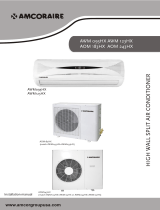
11
designed to protect against extreme high pressure. The relief port
has an operating range between 550 to 625 psig differential
pressure (Copeland). Scrolls have a variety of shut down solutions,
depending on model, to prevent backward rotation and eliminate
the need for cycle protection.
Some sizes may include a traditional reciprocatin g compressor.
These compressors have standard pistons valves, overloads, and
internal pressure relief
Some sizes may include a single cylinder rotary compressor. This
compressor utilizes a rotor which is positioned eccentrically with
respect to the shell. Refrigerant gas is ported directly into the
compression chamber and discharged into the surrounding area. It
is also known as a “high --side” design since high pressure gas
surrounds the motor and compression chamber. The majority of the
shell will be hot to the touch. The rotary compressor also utilizes
an external built--in accumulator to reduce the likelihood of
refrigerant liquid from entering the compressor.
Compressor Failures
Compressor failures are classified in 2 broad failure categories;
mechanical and electrical. Both types are discussed below.
Mechanical Failures
A compressor is a mechanical pump driven by an electric motor
contained in a welded or hermetic shell. In a mechanical failure,
motor or electrical circuit appears normal, but compressor does not
function normally.
ELECTRICAL SHOCK HAZARD
Failure to follow this warning could result in personal
injury or death.
Do not supply power to unit with compressor terminal box
cover removed.
!
WARNING
ELECTRICAL SHOCK HAZARD
Failure to follow this warning could result in personal
injury or death.
Exercise extreme caution when reading compressor currents
when high --voltage power is on. Correct any of the
problems described below before installing and running a
replacement compressor.
!
WARNING
Locked Rotor
In this type of failure, compressor motor and all starting
components are normal. When compressor attempts to start, it
draws locked rotor current and cycles off on internal protection.
Locked rotor current is measured by applying a clamp-- on ammeter
around common (blk) lead of compressor. Current drawn when it
attempts to start is then measured. Locked rotor amp (LRA) value
is stamped on compressor nameplate.
If compressor draws locked rotor amps and all other external
sources of problems have been eliminated, compressor must be
replaced. Because compressor is a sealed unit, it is impossible to
determine exact mechanical failure. However, complete system
should be checked for abnormalities such as incorrect refrigerant
charge, restrictions, insufficient airflow across indoor or outdoor
coil, etc., which could be contributing to the failure.
Runs, Does Not Pump
In this type of failure, compressor motor runs and turns
compressor, but compressor does not pump refrigerant. A
clamp--on ammeter on common leg shows a very low current draw,
much lower than rated load amp (RLA) value stamped on
compressor nameplate. Because no refrigerant is being pumped,
there is no return gas to cool compressor motor. It eventually
overheats and shuts off on its internal protection.
Noisy Compressor
Noise may be caused by a variety of internal and external factors.
Careful attention to the “type” of noise may help identify the
source. The following are some examples of abnormal conditions
that may create objectionable noise:
1. A gurgling sound may indicate a liquid refrigerant
floodback during operation. This could be confirmed if
there is no compressor
superheat. A compressor superheat
of “0” degrees would indicate liquid refrigerant returning to
the compressor. Most common reasons for floodback are:
loss of evaporator blower, dirty coils, and improper airflow.
2. A rattling noise may indicate loose hardware. Inspect all
unit hardware including the compressor grommets.
3. An internal “thunking”, “thumping”, “grinding” or
“rattling” noise could indicate compressor internal failures
and may be verified by comparing the compressor
amperage to what the compressor should be drawing
according to a manufacturer’s performance data.
4. A whistling or squealing noise during operation may
indicate a partial blockage of the refrigerant charge.
5. A whistle on shut down could indicate a partial leak path as
refrigerant is equalizing from high to low side. On
occasion, an in--line discharge check valve has prevented
this sound.
6. If a compressor hums but won’t start it could indicate either
a voltage or amperage issue. Verify adequate voltage and
operational start components if installed. If it is drawing
excessive amperage and voltage doesn’t appear to be the
problem it may be assumed a locked condition. Ensure
refrigerant has had ample time to equalize and boil out of
the compressor before condemning.
7. When a heat pump switches into and out of defrost, a
”swooshing” noise is expected due to the rapid pressure
change within the system. Check that the defrost thermostat
or thermistor is operating properly. Insulating the defrost
sensing device may also help.
Electrical Failures
The compressor mechanical pump is driven by an electric motor
within its hermetic shell. In electrical failures, compressor does not
run although external electrical and mechanical systems appear
normal. Compressor must be checked electrically for abnormalities.
Before troubleshooting compressor motor, review this description
of compressor motor terminal identification.
Single--Phase Motors
To identify terminals C, S, and R:
1. Turn off all unit power.
2. Discharge run and start capacitors to prevent shock.
3. Remove all wires from motor termin als.
4. Read resistance between all pairs of terminals using an
ohmmeter on 0 --10 ohm scale.
5. Determine 2 terminals that provide greatest resistance
reading.
Through elimin ation, remaining terminal must be common (C).
Greatest resistance between common (C) and another terminal
indicates the start winding because it has more turns. This terminal
is the start (S). The remaining terminal will be run winding (R).
NOTE: If compressor is hot, allow time to cool and internal line
break to reset. There is an internal line break protector which must
be closed.
All compressors are equipped with internal motor protection. If
motor becomes hot for any reason, protector opens. Compressor





















